*An article extracted from the original interview by Berenice Angremy & Jasmine Chang
Gao Qiang & Gao Zhen are two Beijing based brothers. Over the past 20 years, their art has reached various mediums including painting, sculpture, performance & photography. Their works form part of the most prestige collections, such as the China National Museum, the MOMA New York, the Guggenheim Foundation, San Francisco Museum of Modern Art, Centre Pompidou, Montreal Museum of Fine Arts, Victoria & Albert Museum, Princeton University Art Museum and many private collections.
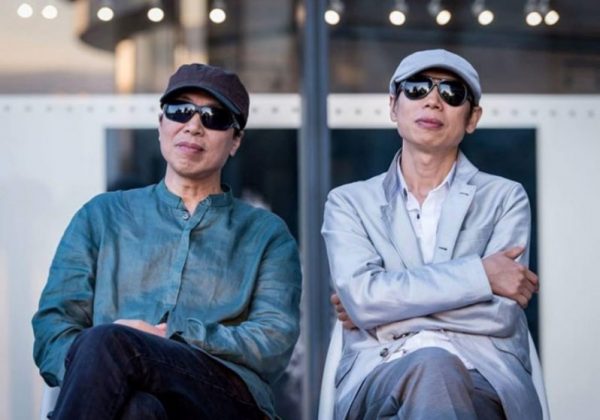
When did you feel that the meaning of space was included in your artistic thinking? Did it begin in 2000 with the series “A Sense of Space”? Had you thought about similar themes prior to your 2000 series?
Gao Brothers: “A Sense of Space” is a work we did in 2000. Before that, although we did not use space as a particular theme in our art, the sense of individuality and space has always been present, and quite deeply so. When we were kids, all six brothers had to share one bed, that was our first memory of space. Later, the sense of space expanded into a social setting. Between 1989 and 2003, we were not allowed to leave the country.
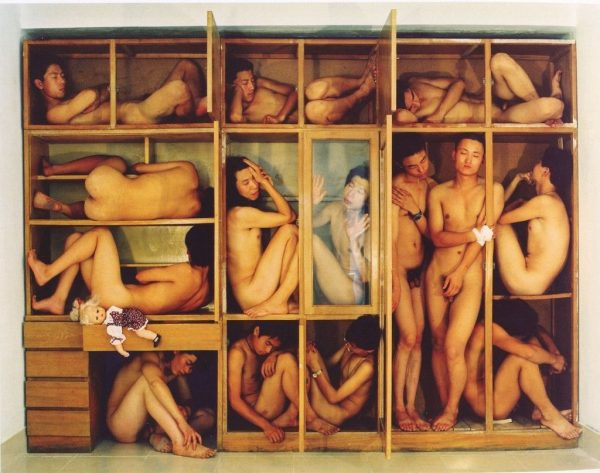
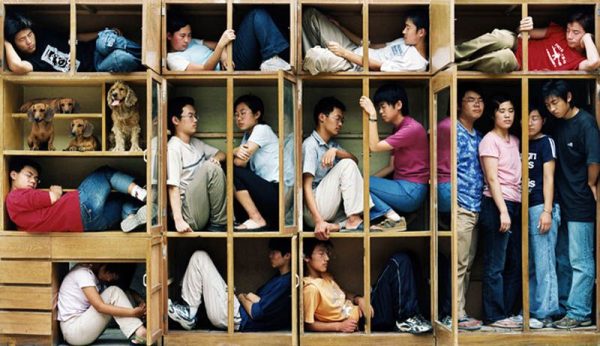
At one point this made us so anxious that we considered leaving illegally. The year the Venice Biennale invited us to do our “The Utopia of Hugging” performance, we could not get a passport. It felt a little like Kafka’s novel, The Castle. Later, we were invited to participate in the International Photography Festival in Rome. We tried to get passports again, and it almost finished in a lawsuit with the police. But after a few days they told us to pick up our passports.
How did you feel when you finally had passports? Did that experience inspire any of your works?
Gao Brothers: At that time, we could not quite believe it. It felt so surreal. When the authorities gave us our passports, they also gave us a briefing. They asked us to promise not to do anything against the government. We said, “Your imagination is even wilder than ours. The only thing we can promise is that we will not lie.” This was during the SARS epidemic, so we ended up not going to the show in Rome. Back when we were planning to leave the country illegally, we thought about turning the whole process into a work of art. But we decided against it. In the end we did not want to take that kind of risk. Perhaps it would have been a success, but then we would not have been able to return to China.
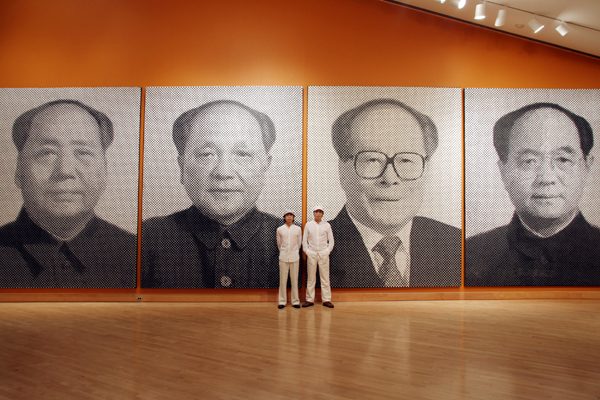
That would have been even more unbearable; after all, this was our place. Later we were allowed to go anywhere in the world without having to worry about not being able to return. Only once we had actually been in another country did we realize our unshakeable affection for our own place. For us, obtaining a passport is a basic right. When that right was taken away from us, we felt closed in. Going abroad in and on itself is not that important. But as artists, of course we hoped to have the chance to communicate with the international art community. Also, shows we were holding on the Mainland were often banned. We thought that this situation might never change, it showed us how absurd reality was.
Can you talk about your experience before and after you created the works “The Forever Unfinished Building” and “Sense of Space”? Do these works have any connection with your relationship to the world and your position in it?
Gao Brothers: The idea for “The forever Unfinished building” grew out of the “Hug/ Embrace” series.
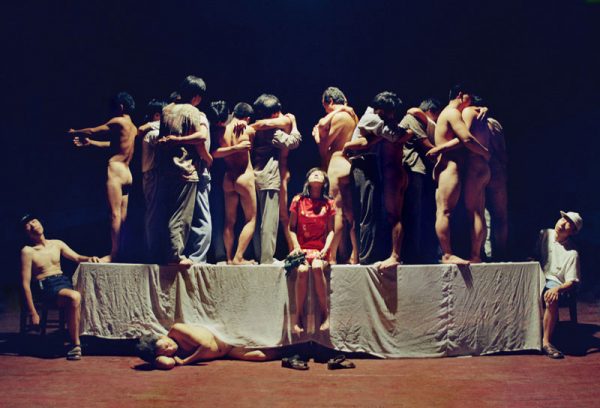
“The Utopia of the 20 minutes Embrace” was first created on the banks of the Yellow River. Then we took our volunteers to Jinan. In Jinan, we saw a building abandoned in mid-construction, just on the shore of Lake Daming. We felt that it had a metaphorical quality, not unlike contemporary China. For so many years, China has been undergoing a destruction and re-construction process.
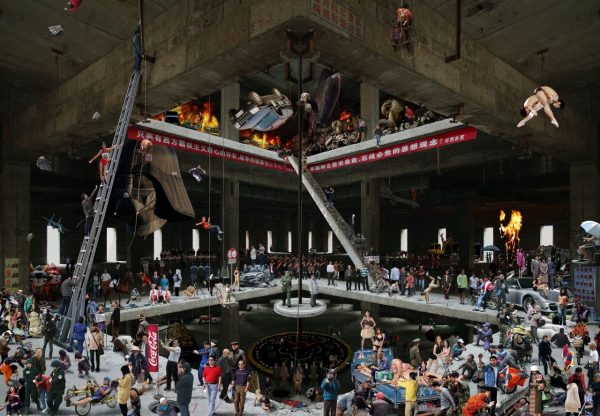
The whole country looks like a building endlessly in the making. We used that space in Jinan as a site for our photography. We went there a lot. But the images in the final artwork were taken at different times and places, they are not all from that specific building. “The Forever Unfinished Building” is also related to “A Sense of Space”, as it also expresses the relationship between people and space. “A Sense of Space” is a combination of symbolic architecture, involving not only physical space, but also, and even more so, spiritual space. “The Forever Unfinished Building” pushed the idea of “A Sense of Space” one step further, it incorporates more social elements.
I think that a study of space is also a study of human nature. How do you define human space? How do you define a social space? And does your sense of space relate to a sense of frustration between fantasy and reality?
Gao Brothers: Unfinished architecture is a metaphor for a Chinese reality. China is like a huge construction site. Its political ideology or economic status, social system, and urban design are all in an unfinished state. On the other hand, unfinished architecture is also a metaphor for humanity’s incomplete life process. In its incomplete construction, contemporary China is distinct from the rest of the world. When you are in an unfinished, dilapidated building, you feel desolate – old and abandoned. You also sense danger. There are traps everywhere, you have no protection.
How does the material you choose express your ideas?
Gao Brothers: We get a lot of our material from the news. For a variety of reasons, many images we see there make their way into our work. We do not read contemporary fiction, if you read news from the Sina website**, you will find that China is so strange and so surreal a place, it is beyond the imagination of any artist or writer, and so much more absurd.
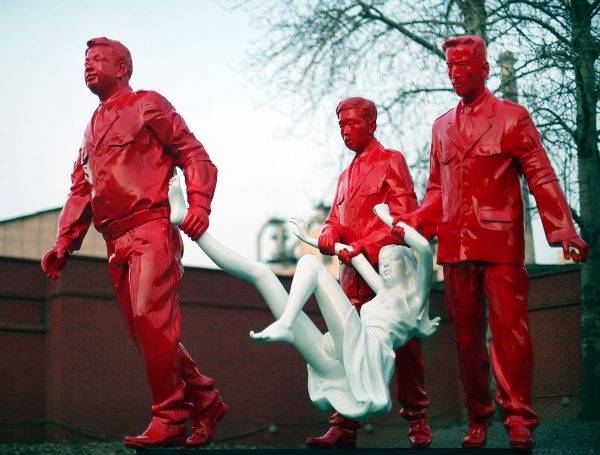
There are also compositional considerations – how to arrange things, what to place at the top, and what at the bottom. If it is a group of people, we have to consider the relationship between these people. Some people ask us why we do not hire an assistant. But assistants will not do. Someone once said: the only thing that lasts is chaos.
Your earlier works were romantic but also serious. In the past few years however, there seems to be more and more humor in your work. A mixture of carnival and theater, sometimes bordering on drama. Why is that? Does humor lend itself to your work? Or are you expressing a cynical attitude toward society?
Gao Brothers: A sense of humor is essential. Without it, life would be difficult. Humor is a way to make life palatable, it also allows art to be distinguished from dogma, and lends flexibility to the composition process. In reality, humor can be a state of tension and seriousness; things can actually be both funny and grave. We have to balance these two extremes so that humor does not distract one from the theme. “The Forever Unfinished Building” is rich in detail – the composition is forceful. Details which contrast with each other are like musical notes.
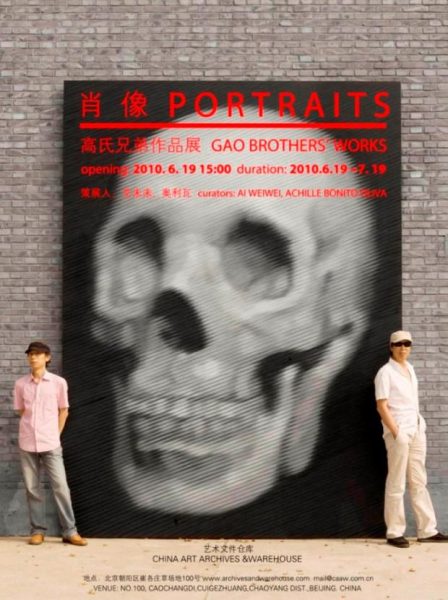
When we started the project, we did not know what it would lead to. We just felt that architecture could be transformed into something metaphorical. It was like playing a game of chess. An image that we began with would be replaced by another image – image by image, piece by piece. It is not that our earlier works were humorless. For example, “Miss Mao” was cute and horrific at the same time, it symbolized China’s new generation. Sometimes, we do not create an image to either criticize or be humorous. We simply hope that the images we create have a unique quality. Through deconstruction and appropriation, a fixed image can become subtle and ambiguous. Some people say that free-thinking intellectuals today should be wise and have a strong moral commitment, like Vaclav Havel, a politician with a modern mind. Eastern Europe has sustained some individualism and freedom even though it has undergone the purge of Communism. In comparison, Chinese intellectuals are frivolous. In the West, intellectuals have more allusions to draw on – it might have something to do with the background of Christianity.
Since the 80s, you have been very active artists. You have worked with sculpture, installation, and photography. What has digital technology brought to your art?
Gao Brothers: The computer has liberated art in the traditional sense. The visual effects achieved by painting can be achieved by photography as well. Photography is also a freer and more spontaneous medium. But still, we try to limit the use of technology because if the technology is too obvious, it detracts from the themes the work is trying to express. “The Forever Unfinished Building ” expresses a sense of chaos.
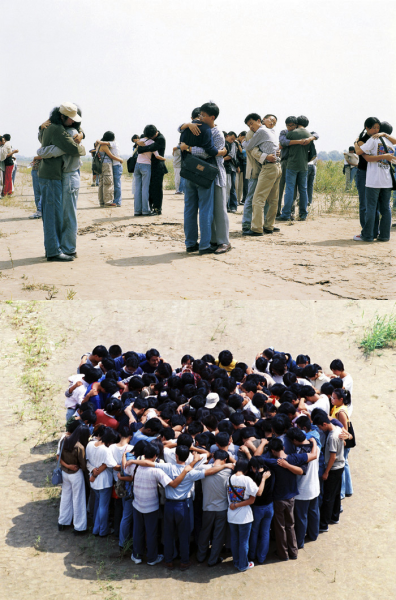
“The Utopia of the 20 minute embrace” expresses a sense of order and separation. It is an extension of “A Sense of Space.” “Utopia” expresses our understanding of space, how to utilize space within a limited frame, the relationship of space with nature. In reality, people are interacting within a limited space: physically, spiritually and also socially. In fact, “Utopia” is an anti-Utopian work.
Do you feel that as a creator you have a responsibility towards the existing society?
Gao Brothers: Yes, of course. We always feel that by working in culture, we have a social responsibility. We cannot go to extremes. We cannot intrude on others with our own pursuit of freedom. Our work expresses the relationship between ourselves and others…between ourselves and society. The work does not need to be labeled. The social responsibility we are talking about is more like a civic consciousness.
We should always know where we stand. People ask us, “How are you doing?” We say, “Not bad.” People ask, “How are the Chinese doing?” We cannot say, “Not bad.” We do not like to be represented or to represent others. Every individual is a unique life. Whoever represents another person is canceling the life of that person. Some people who stand as intellectuals do not speak with any sense of responsibility. We know our place, and we are normal people. It is just that in an abnormal society, the normal becomes abnormal. Society is not well regulated, the bad becomes the good. In this society, basic judgments and commonsense knowledge are easily confused.
How do you balance artistic creation and responsibility?
Gao Brothers: We rarely use artistic creation to justify our responsibilities. We make discoveries and we incorporate the reality we see into our art. The word creation sanctifies this process.
How do you look upon China’s contemporary art market?
Gao Brothers: There is a so-called “For Others” market – with Westerners as the major buyers. The Chinese have not developed a taste for buying art, they are still learning to appreciate it – one step at a time. Generally speaking, we feel that the media is giving the market too much hype. It is a market which should develop at its own pace. But now it has become the only place where there is excitement about art. Artists should not focus too much on it. It is really frustrating to see that the market has become the only benchmark by which to judge the value of art.
Do you think the art market has helped you gain recognition abroad – and only abroad?
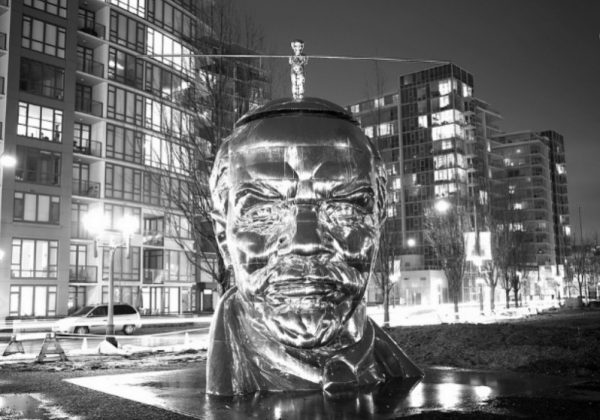
Gao Brothers: We are relatively lucky. Our work sells. It does not matter whether we get recognition at home or abroad, the world has become a global village. But on the other hand, we hope our work will sell more evenly, both abroad and here at home. We are still at the early stages during which Chinese art is gaining attention and momentum. If our work could be sold without being labeled or categorized, it would be a more normal situation.
How do you explain that many of the viewers who most identify with your work are from the West?
Gao Brothers: This is a very practical matter. Many of our works are banned in China, and we are relatively passive about it. Many overseas collectors invite us to participate in shows abroad. But actually some of our work would be more appropriate here, because it depicts the reality here. It is quite a dilemma.
On the other hand, works like “A Sense of Space” express a spiritual oppression which is universal. We create from the perspective of our own living environment. As for whom identifies with the work, that is up to the audience to decide.
Do you think the colonialist attitudes of Western viewers which critics were discussing ten years ago are still relevant today?
Gao Brothers: We should face this so-called Colonialism with some detachment. Evoking this colonialist argument makes us seem fragile. If today we still think of the West as an enemy, we are much too diffident, as if the West was up to some conspiracy. As far as we know, most people who buy our work do so because they personally like it. For example, Uli Sigg bought our work.
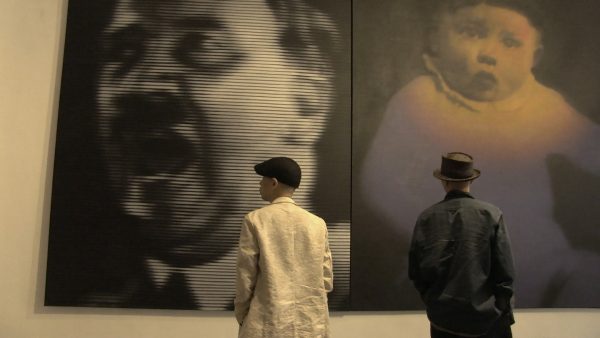
We did not see that he had any specific plan. He looked at the work for a long time and he bought it. He did not choose to do so because of some cultural strategy. Many people, when they are buying art, are not influenced by institutions. The “conspiracy theories” are a continuation of a Cold War mentality. If we look at the positive side, the West has developed democracy and modern thought. It has brought us into this game. What is so bad about that?
We often see you around in 798 Art District. At the same time, we feel that you are somewhat detached from the art scene there. It seems like you intend to remain in the margins of it. Is that so? If yes, why?
Gao Brothers: We seldom think in terms of cliques and try to avoid them. There are a lot of spaces here that we have never been to. People come to hang out in our space, and we welcome them. We have a very diverse group of friends, many of them come from outside the art world. People in the art world tend to be simplistic, we cannot seem to communicate with them. Some of our friends are writers and intellectuals who focus on social issues. Those are the ones we get along better with.
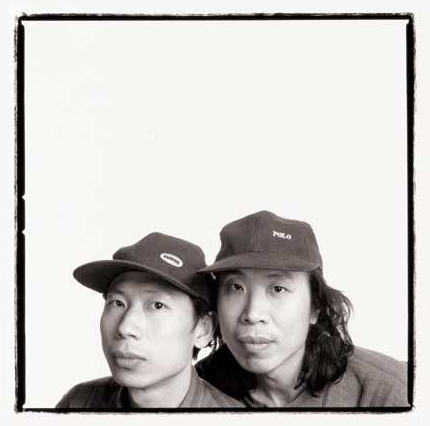
What have you been busy with?
Gao Brothers: We are working on several projects. In the flea market in Moscow, we bought a bust of Lenin. We made a much bigger one – five meters tall. Inside the bust, we have installed a video. We are also considering to make the story of Lin Zhao into an artwork.
